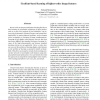CVPR
2012
IEEE
12 years 10 months ago
2012
IEEE
We present a novel method for analyzing social behavior. Continuous videos are segmented into action ‘bouts’ by building a temporal context model that combines features from s...
CVPR
2012
IEEE
12 years 10 months ago
2012
IEEE
Many human action recognition tasks involve data that can be factorized into multiple views such as body postures and hand shapes. These views often interact with each other over ...
CVPR
2012
IEEE
12 years 10 months ago
2012
IEEE
We propose an approach for cross-view action recognition by way of ‘virtual views’ that connect the action descriptors extracted from one (source) view to those extracted from...
CVPR
2012
IEEE
12 years 10 months ago
2012
IEEE
We propose a framework that performs action recognition and identity maintenance of multiple targets simultaneously. Instead of first establishing tracks using an appearance mode...
ICCV
2011
IEEE
12 years 11 months ago
2011
IEEE
Recognition of human actions in a video acquired by a moving camera typically requires standard preprocessing steps such as motion compensation, moving object detection and object ...
101
click to vote
WACV
2012
IEEE
13 years 3 months ago
2012
IEEE
Human movements are important cues for recognizing human actions, which can be captured by explicit modeling and tracking of actor or through space-time low-level features. Howeve...
ICCV
2011
IEEE
13 years 7 months ago
2011
IEEE
In this paper we develop an algorithm for action recognition and localization in videos. The algorithm uses a figurecentric visual word representation. Different from previous ap...
ICCV
2011
IEEE
13 years 7 months ago
2011
IEEE
Progress in action recognition has been in large part due to advances in the features that drive learning-based methods. However, the relative sparsity of training data and the ri...
ICCV
2011
IEEE
13 years 7 months ago
2011
IEEE
Recent work on unsupervised feature learning has shown that learning on polynomial expansions of input patches, such as on pair-wise products of pixel intensities, can improve the...
ICCV
2011
IEEE
13 years 7 months ago
2011
IEEE
We present an approach for dictionary learning of action attributes via information maximization. We unify the class distribution and appearance information into an objective func...


